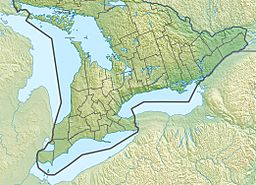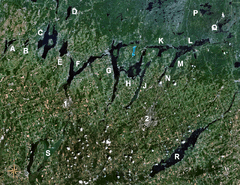Jack Lake (Peterborough County) facts for kids
Quick facts for kids Jack Lake |
|
|---|---|
| Location | Peterborough County, Ontario |
| Coordinates | 44°41′41″N 78°02′08″W / 44.69472°N 78.03556°W |
| Part of | Great Lakes Basin |
| Primary outflows | Jack Creek |
| Basin countries | Canada |
| Max. length | 6.3 km (3.9 mi) |
| Max. width | 6.1 km (0 mi) |
| Surface elevation | 280 m (920 ft) |
| Settlements | Jack Lake |
Jack Lake is a beautiful lake located in Peterborough County, Ontario, Canada. It's about 160 km (100 mi) northeast of Toronto. This lake is part of the Canadian Shield and the Kawartha lakes region.
Jack Lake is also a reservoir, which means its water levels can be controlled. It's an important part of the Great Lakes Basin. The lake acts as a small starting point for the Trent–Severn Waterway, a famous system of canals and lakes. A small community called Jack Lake is found on the northwest side of the lake. You can reach it by following Peterborough County Road 52.
Contents
About Jack Lake's Shape and Water Flow
How Jack Lake Looks
Jack Lake has a very interesting and uneven shape. It has three main bays that go deep into the land. There are also many smaller bays. Some of the named bays include Brooks Bay in the northwest and Sharpe Bay, which is the largest, in the west. Other bays are Callahan Bay, Long Bay, McCoy Bay, Rathbun Bay, and Redmond Bay.
Water Coming In and Going Out
The main streams that flow into Jack Lake are Apsley Creek and Redmond Creek. Water leaves the lake through Jack Creek. This creek flows out over a small dam at the south end of the lake.
The dam helps control how much water goes into the Trent-Severn Waterway. This is important to keep the waterway deep enough for boats. The water level at the dam changes throughout the year. It's usually lowest in January (about 1.2 m or 4 ft) and highest in May (about 1.9 m or 6 ft).
Jack Creek eventually flows into Stony Lake, then Clear Lake, the Otonabee River, Rice Lake, and finally the Trent River, which leads to Lake Ontario. Jack Lake is located at an elevation of 280 m (919 ft) above sea level.
Jack Lake's Natural Environment
Studying the Lake
For many years, Jack Lake was used as a special place for scientific research. Environment Canada's National Water Research Institute (NWRI) studied the lake until the 1990s. Many universities also did research here. This work helped scientists understand how human activities and natural changes affect freshwater environments.
Fish and Wildlife
Jack Lake was originally home to fish like bass and trout. As the lake became more popular for tourism, other fish species were introduced. Starting around the 1920s, fish like muskellunge, walleye, rock bass, and perch were added. More recently, Black Crappie have also been introduced. These fish are now very popular with people who enjoy fishing in both summer and winter.
There are ongoing efforts by the government and local groups to protect the lake's environment. These programs help keep the lake healthy for all its plants and animals.
Fun at Jack Lake
Jack Lake is a great place for recreation. There is a resort located on the northwest shore of the lake. Visitors can enjoy fishing, boating, and other outdoor activities.



